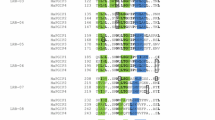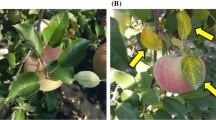Abstract
A cDNA encoding polygalacturonase-inhibiting protein (PGIP) from mature apple fruit has been cloned and characterized. The open reading frame encodes a polypeptide of 330 amino acids, in which 24 amino acids at the N-terminus comprise the signal peptide. Apple PGIP contains 10 imperfect leucine-rich repeat sequence motifs averaging 24 amino acids in length. In addition to the 1.3 kb PGIP transcript, the cloned cDNA also hybridized to RNA molecules with sizes of 3.2 and 5.0 kb. Genomic DNA analysis revealed that the apple PGIP probably belongs to a small family of genes. PGIP transcript levels varied in fruit collected at different maturities, suggesting the gene is developmentally regulated. Very high PGIP transcript levels were detected in decayed areas and the tissue adjacent to the inoculation sites of Penicillium expansum and Botrytis cinerea. However, no increase in the amount of PGIP transcript in tissue distant from the decayed region was observed. Wounding on fruit also induced PGIP gene expression but to a much lessser extent when compared with decayed areas. After storage at 0 °C for 1 month, the abundance of PGIP transcript in ripe fruit was substantially increased. The PGIP gene in immature and ripe fruit was rapidly up-regulated by fungal infections, while in stored fruit the induction was very limited and concurred with an increase of fruit susceptibility to fungal colonization. Since PGIP gene expression is regulated by fruit development and responds to wounding, fungal infection and cold storage, these observations suggest that apple PGIP may have multiple roles during fruit development and stress response.
Similar content being viewed by others
References
Albersheim P, Darvill A, Augur C, Cheong J, Eberhard S, Hahn MG, Marfa V, Mohnen DO'Neill MA, Spiro MD, York WS: Oligosaccharins: oligosaccharide regulatory molecules. Acc Chem Res 25: 77–83 (1992).
Altschul SF, Gish W, Millar W, Myers EW, Lipman DJ: Basic local alignment search tool. J Mol Biol 215: 403–410 (1990).
Bateman DF, Millar RL: Pectic enzymes in tissue degradation. Annu Rev Phytopath 4: 119–146 (1966).
Bent AF, Kunkel BN, Dahlbeck D, Brown KL, Schmidt R, Giraudat J, Leung J, Staskawicz BJ: RPS2 of Arabidopsis thaliana: a leucine-rich repeat class of plant disease resistance genes. Science 265: 1856–1860 (1994).
Bergmann CW, Ito Y, Singer D, Albersheim P, Darvill AG, Benhamou N, Nuss L, Salvi G, Cervone F, De Lorenzo G: Polygalacturonase-inhibiting protein accumulates in Phaseolus vulgaris L. in response to wounding, elicitors and fungal infection. Plant J 5: 625–634 (1994).
Cervone F, Hahn MG, De Lorenzo G, Darvill A, Albersheim P: Host-pathogen interactions. XXXIII. A plant protein concerts a fungal pathogenicity factor into an elicitor of plant defense responses. Plant Physiol 90: 542–548 (1989).
Chang C, Schaller GE, Patterson SE, Kwok SF, Meyerowitz EM, Bleecker AB: The TMK1 gene from Arabidopsis codes for a protein with structural and biochemical characteristics of a receptor protein kinase. Plant Cell 4: 1263–1271 (1992).
Collmer A, Keen NT: The role of pectic enzymes in plant pathogenesis. Annu Rev Phytopath 24: 383–409 (1986).
Conway WS: Effect of postharvest calcium treatment on decay of Delicious apples. Plant Dis 66: 402–403 (1982).
Cooper RM: Pathogen-induced changes in host ultrastructure. In: Staples RC, Toenniesen CH(eds) Plant Disease Control: Resistance and Susceptibility, pp. 105–142. John Wiley, New York (1981).
Desiderio A, Aracri B, Leckie F, Mattei B, Salvi G, Tigelaar H, van Roekel JSC, Baulcombe DC, Melchers LS, De Lorenzo G, Cervone F: Polygalacturonase-inhibiting proteins (PGIPs) with different specificities are expressed in Phaseolus vulgaris. Mol Plant-Microbe Interact 10: 852–860 (1997).
Devereux J, Haeberli P, Smithies O: A comprehensive set of sequence analysis programs for the VAX. Nucl Acids Res 12: 387–395 (1984).
Devoto A, Clark AJ, Nuss L, Cervone F, De Lorenzo G: Developmental and pathogen-induced accumulations of transcripts of polygalacturonase-inhibiting protein in Phaseolus vulgaris L. Planta 202: 284–292 (1997).
Dixon MS, Jones DA, Keddie JS, Thomas CM, Harrison K, Jones JDG: The tomato Cf-2 disease resistance locus comprises two functional genes encoding leucine-rich repeat proteins. Cell 84: 451–459 (1996).
Doyle JJ, Doyle JL: Isolation of plant DNA from fresh tissue. Focus 12: 13–15 (1990).
Favaron F, D'Ovidio R, Porceddu E, Alghisi P: Purification and molecular characterization of a soybean polygalacturonase-inhibiting protein. Planta 195: 80–87 (1994).
Hahn MG, Bucheli P, Cervone F, Doares SH, O'Neill RA, Darvill AG, Albersheim P: The roles of cell wall constituents in plant-pathogen interactions. In: Nester E, Kosuge T (eds) Plant-Microbe Interactions, vol 3, pp. 131–181. Macmillan, New York (1989).
Jones TM, Anderson AJ, Albersheim P: Host-pathogen interaction. IV. Studies on the polysaccharide-degrading enzymes secreted by Fusarium oxysporum f. sp. lycopersici. Physiol Plant Path 2: 153–166 (1972).
Jones DA, Thomas CM, Hammond-Kosack KE, Balint-Kurti PJ, Jones JDG: Isolation of the tomato Cf-9 gene for resistance to Cladosporium fulvum by transposon tagging. Science 266: 789–793 (1994).
Karr AL, Albersheim P: Polysaccharide-degrading enzymes are unable to attack cells without prior action by a 'wallmodifying' enzyme. Plant Physiol 46: 69–80 (1970).
Kobe B, Deisenhofer J: Crystal structure of porcine ribonuclease inhibitor, a protein with leucine-rich repeats. Nature 366: 751–756 (1993).
Kobe B, Deisenhofer J: The leucine-rich repeat: a versatile binding motif. Trends Biochem Sci 19: 415–421 (1994).
Lawrence GJ, Finnegan EJ, Ayliffe MA, Ellis JG: The L6 gene for flax rust resistance is related to the Arabidopsis bacterial resistance gene RPS2 and the tobacco viral resistance gene N. Plant Cell 7: 1195–1206 (1995).
Mindrinos M, Katagiri F, Yu G, Ausubel FM: The A. thaliana disease resistance gene RPS2 encodes a protein containing a nucleotide-binding site and leucine-rich repeats. Cell 78: 1089–1099 (1994).
Powell ALT, Stotz HU, Labavitch JM, Bennett AB: Glycoprotein inhibitors of fungal polygalacturonases. In: Daniel et al. (eds) Advances in Molecular Genetics of Plant-Microbe Interactions 3, pp. 399–402. Kluwer Academic Publishers, Dordrecht, Netherlands (1994).
Pressey R: Polygalacturonase inhibitors in bean pods. Phytochemistry 42: 1267–1270 (1996).
Ross GS, Knighton ML, Lay-Yee M: An ethylene-related cDNA from ripening apples. Plant Mol Biol 19: 231–238 (1992).
Sambrook J, Fritsch EF, Maniatis T: Molecular Cloning: A Laboratory Manual, 2nd ed. Cold Spring Harbor Laboratory Press, Cold Spring Harbor, NY (1989).
Selden RF: Analysis of RNA by Northern hybridization. In: Ausubel F, Brent R, Kingston R, Moore D, Seidman J, Smith J, Struhl K (eds) Current Protocols in Molecular Biology, pp. 4.9.1–4.9.8. John Wiley, New York (1987).
Simpson CG, MacRae E, Gardner RC: Cloning of a polygalacturonase-inhibiting protein from kiwifruit (Actinidia deliciosa). Plant Gene Register (PGR95–037). Plant Physiol 108: 1748 (1995).
Song W, Wang G, Chen L, Kim H, Pi L, Holsten T, Gardner J, Wang B, Zhai W, Zhu L, Fauquet C, Ronald P: A receptor kinase-like protein encoded by the rice disease resistance gene, Xa21. Science 270: 1804–1806 (1995).
Stotz HU, Contos JA, Powell ALT, Bennett AB, Labavitch JM: Structure and expression of an inhibitor of fungal polygalacturonases from tomato. Plant Mol Biol 25: 607–617 (1994).
Stotz HU, Powell ALT, Damon SE, Greve LC, Bennett AB, Labavitch JM: Molecular characterization of a polygalacturonase inhibitor from Pyrus communis L. cv. Barlett. Plant Physiol 102: 133–138 (1993).
Toubart P, Desiderio A, Salvi G, Cervone F, Daroda L, De Lorenzo G, Bergmann C, Darvill AG, Albersheim P: Cloning and characterization of the gene encoding the endopolygalacturonase-inhibiting protein (PGIP) of Phaseolus vulgaris L. Plant J 2: 367–373 (1992).
Verwoerd TC, Dekker BMM, Hoekema A: A small-scale procedure for the rapid isolation of plant RNAs. Nucl Acids Res 17: 2362 (1989).
Walton, JD: Deconstructing the cell wall. Plant Physiol 104: 1113–1118 (1994).
Walker JC: Receptor-like protein kinase genes of Arabidopsis thaliana. Plant J 3: 451–456 (1993).
Whitham S, Dinesh-Kumar SP, Choi D, Hehl R, Corr C, Baker B: The product of the tobacco mosaic virus resistance gene N: similarity to toll and the interleukin-1 receptor. Cell 78: 1101–1115 (1994).
Yao C, Conway WS, Sams CE: Purification and characterization of a polygalacturonase-inhibiting protein from apple fruit. Phytopathology 85: 1373–1377 (1995).
Yao C, Conway WS, Sams CE: Purification and characterization of a polygalacturonase produced by Penicillium expansum in apple fruit. Phytopathology 86: 1160–1166 (1996).
Author information
Authors and Affiliations
Rights and permissions
About this article
Cite this article
Yao, C., Conway, W.S., Ren, R. et al. Gene encoding polygalacturonase inhibitor in apple fruit is developmentally regulated and activated by wounding and fungal infection. Plant Mol Biol 39, 1231–1241 (1999). https://doi.org/10.1023/A:1006155723059
Issue Date:
DOI: https://doi.org/10.1023/A:1006155723059




